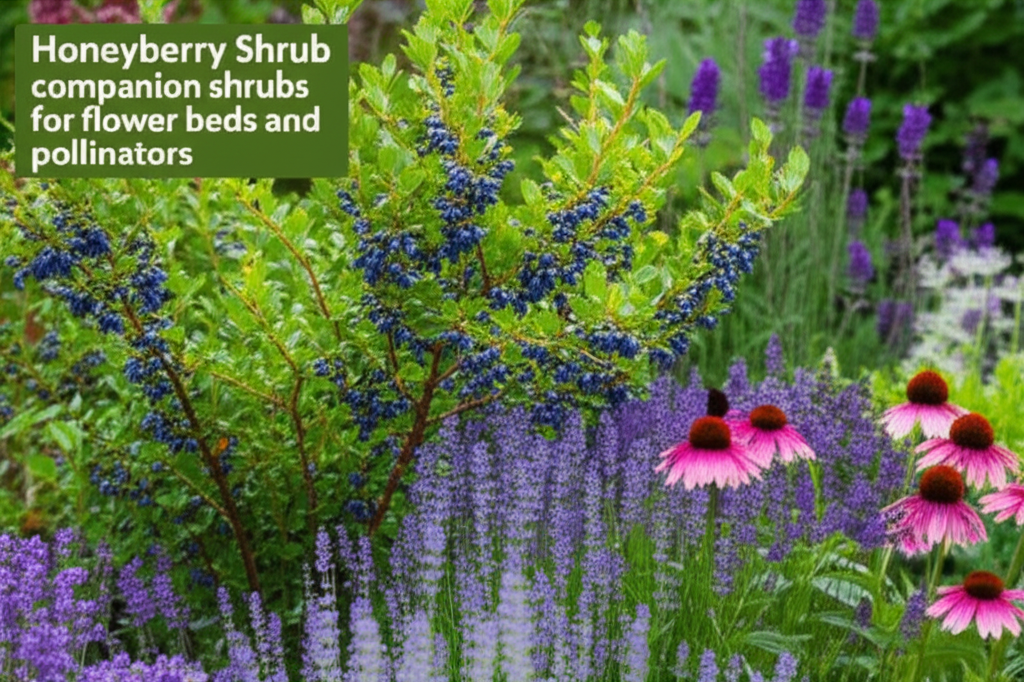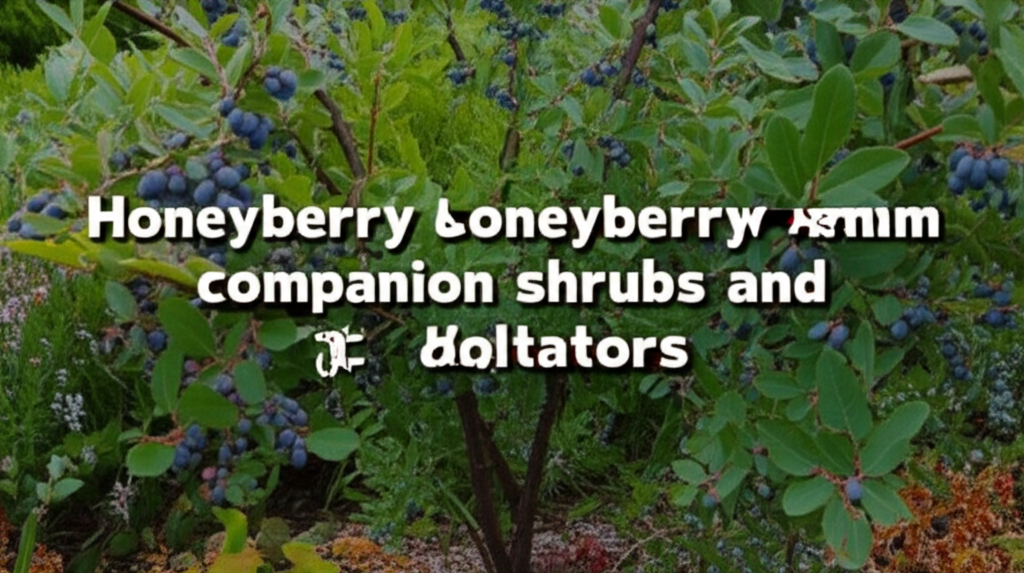Honeyberry (Haskap) bushes are a fantastic addition to any garden, prized for their early spring blooms, delicious tart berries, and impressive hardiness. As their popularity grows, so does the interest in creating harmonious and productive companion plantings. Choosing the right companion shrubs not only enhances the aesthetic appeal of your flower beds but also supports pollinator health and potentially improves honeyberry yield. This guide explores the best shrub companions for your honeyberry planting, focusing on their benefits for both the garden ecosystem and your honeyberry harvest.
Understanding Honeyberry Needs and Benefits
Before diving into companion shrub selections, it’s crucial to understand what honeyberries thrive on. These adaptable shrubs generally prefer:
- Full sun to partial shade.
- Well-draining soil, though they are tolerant of a range of soil types.
- Slightly acidic to neutral pH.
- Adequate moisture, especially during fruiting.
- Cross-pollination for optimal berry production.
The benefits of honeyberries extend beyond their tasty fruit. Their early spring flowers provide a vital nectar and pollen source for emerging pollinators, including bees, butterflies, and other beneficial insects, at a time when other floral resources are scarce.
Why Companion Planting for Honeyberries?

Companion planting isn’t just about filling space; it’s a strategic approach to gardening that offers several advantages:
- Pollinator Attraction: Planting shrubs that bloom concurrently or sequentially with honeyberries attracts a wider diversity and greater abundance of pollinators.
- Pest Deterrence: Certain companion plants can repel common honeyberry pests through their scent or by attracting predatory insects.
- Soil Health Improvement: Nitrogen-fixing shrubs or those with deep root systems can improve soil structure and fertility.
- Aesthetic Appeal: Combining plants with different bloom times, textures, and colors creates a visually dynamic and engaging garden throughout the seasons.
- Extended Harvests: While honeyberries fruit early, other companion shrubs might offer later blooms or berries, extending the garden’s edible and ornamental season.
Key Facts About Honeyberry Companion Shrubs
Here’s a comparison of some excellent shrub companions for your honeyberry planting, considering their bloom time, pollinator attraction, and other benefits.
| Shrub Type | Bloom Time | Pollinator Appeal | Additional Benefits | Sunlight Needs | Soil Preference | Mature Size (Approx.) |
|---|---|---|---|---|---|---|
| Serviceberry (Amelanchier spp.) | Early Spring (Concurrent with Honeyberry) | High (Bees, Butterflies) | Edible berries, attractive fall color, wildlife food source. | Full Sun to Part Shade | Adaptable, prefers well-drained | 15-25 ft tall, 10-15 ft wide |
| Blueberry (Vaccinium spp.) | Mid to Late Spring | High (Bees, especially bumblebees) | Edible berries, acidic soil improvement, attractive foliage. | Full Sun | Acidic, well-drained, moist | 3-6 ft tall, 3-5 ft wide |
| Elderberry (Sambucus spp.) | Late Spring to Early Summer | Very High (Bees, Butterflies, Flies) | Edible berries (cooked), attracts beneficial insects, fast-growing. | Full Sun to Part Shade | Moisture-retentive, adaptable | 5-12 ft tall, 5-12 ft wide |
| Forsythia (Forsythia spp.) | Early Spring (Concurrent with Honeyberry) | Moderate (Bees) | Vibrant yellow spring flowers, low maintenance. | Full Sun | Adaptable, prefers well-drained | 8-10 ft tall, 8-10 ft wide |
| Lilac (Syringa spp.) | Late Spring | High (Bees, Butterflies) | Fragrant flowers, attractive to a variety of pollinators. | Full Sun | Adaptable, prefers well-drained | 4-15 ft tall, 4-15 ft wide |
| Viburnum (Viburnum spp.) | Spring to Early Summer (Varies by species) | High (Bees, Butterflies) | Attractive flowers, berries for birds, varied forms. | Full Sun to Part Shade | Adaptable, prefers well-drained | 3-20 ft tall, 3-15 ft wide (Varies) |
Top Companion Shrub Recommendations for Honeyberry Beds
Let’s delve into the specific qualities that make these shrubs excellent partners for honeyberries.
Serviceberry (Amelanchier spp.)
Serviceberry, also known as Juneberry or Shadbush, is arguably one of the most ideal companions for honeyberries. Its timing is impeccable, with white, star-like flowers appearing in early spring, often coinciding with or just preceding honeyberry blooms.
Why Serviceberry Works
- Pollinator Synergy: Both honeyberries and serviceberries are early bloomers, providing a continuous food source for emerging pollinators. Their co-blooming maximizes the attraction of bees, bumblebees, and other essential pollinators to the area.
- Edible Overlap: Serviceberries produce small, sweet, blueberry-like fruits in early summer, offering a second harvest after the honeyberries.
- Aesthetic Appeal: Serviceberries often have beautiful white flowers in spring, followed by attractive foliage that turns vibrant shades of orange and red in the fall. Many varieties also have attractive bark.
- Adaptability: They are relatively adaptable to various soil conditions and sunlight levels, making them a versatile choice.
Consider cultivars like Amelanchier canadensis or Amelanchier alnifolia for their vigor and fruit production.
Blueberry (Vaccinium spp.)
Blueberries are natural allies for honeyberries, not just in their shared love for slightly acidic soil but also in their appeal to similar pollinators.
Why Blueberry Works
- Shared Pollinators: Blueberries are a favorite of bumblebees, which are also excellent pollinators for honeyberries. Planting them together creates a powerful draw for these crucial insects.
- Soil Preference: While honeyberries are more tolerant, blueberries thrive in acidic soil. If you are amending your soil for blueberries, you’ll be creating a more favorable environment for some honeyberry varieties as well.
- Extended Berry Season: Blueberries ripen later than honeyberries, typically in mid-summer, providing a delicious extension to your fruit-gathering calendar.
- Nutritional Benefits: Both fruits are packed with antioxidants.
Ensure you select varieties suited to your climate and soil pH. Popular choices include ‘Sunshine Blue’ (low chill), ‘Duke’, or ‘Bluecrop’.
Elderberry (Sambucus spp.)
Elderberries are robust, fast-growing shrubs that offer significant benefits for both garden aesthetics and pollinator support.
Why Elderberry Works
- Pollinator Magnet: Elderberry flowers are a rich source of nectar and pollen, attracting a wide array of pollinators, including bees, butterflies, hoverflies, and other beneficial insects that can help control garden pests.
- Bloom Time Complement: While elderberries bloom a bit later than honeyberries, their extensive clusters of creamy white flowers in late spring and early summer provide continuous floral resources.
- Wildlife Attraction: The dark purple-black berries that follow the flowers are a favorite of many bird species, adding life and movement to the garden.
- Fast Growth: Elderberries can quickly establish themselves, filling out garden spaces and providing a backdrop for the honeyberry bushes.
American Elderberry (Sambucus canadensis) is a common and highly productive choice. Consider cultivars like ‘Black Lace’ for its striking dark foliage, which offers a beautiful contrast to lighter-flowered shrubs.
Forsythia (Forsythia spp.)
For a blast of early spring color, Forsythia is an unbeatable companion.
Why Forsythia Works
- Early Bloom and Pollinator Support: Forsythia’s brilliant yellow flowers appear very early in spring, often before honeyberries fully leaf out. This provides an initial, albeit not as protein-rich, food source for early-emerging bees.
- Visual Appeal: The vibrant yellow bloom is a cheerful herald of spring and creates a stunning visual display when planted near the delicate white or pale pink honeyberry flowers.
- Low Maintenance: Forsythias are exceptionally hardy and low-maintenance, requiring little more than occasional pruning to maintain shape.
While Forsythia’s nectar is not as highly valued by bees as that of other flowering shrubs, its sheer abundance and early arrival make it a beneficial, if not essential, companion for overall pollinator support.
Lilac (Syringa spp.)
Lilacs offer unparalleled fragrance and beauty in the late spring garden.
Why Lilac Works
- Fragrant Appeal: The intoxicating scent of lilacs attracts a wide variety of bees and butterflies.
- Pollinator Draw: Their abundant flower clusters provide a significant nectar source for pollinators during their bloom period.
- Aesthetic Contrast: The showy, often fragrant flowers of lilacs provide a beautiful visual and olfactory contrast to the more subtle honeyberry blooms.
- Hardiness: Lilacs are incredibly hardy and long-lived shrubs.
Many varieties exist, from the common French Lilac (Syringa vulgaris) to more compact cultivars. Choose a location where their fragrance can be enjoyed.
Viburnum (Viburnum spp.)
The Viburnum genus is incredibly diverse, offering a wide range of shapes, sizes, and bloom times, making it a flexible companion choice.
Why Viburnum Works
- Varied Bloom Times: Some viburnums bloom very early in spring, potentially overlapping with honeyberries, while others provide blooms later into the season.
- Pollinator Diversity: Many viburnums are attractive to a broad spectrum of pollinators, including bees, butterflies, and hoverflies.
- Ornamental Value: Viburnums offer attractive flowers, often fragrant, and many produce colorful berries that are a valuable food source for birds, particularly in the fall.
- Structure and Form: Their varied growth habits can provide different levels of structure and privacy in a garden bed.
Species like Viburnum carlesii (Korean Spice Viburnum) are prized for their intensely fragrant spring flowers. Viburnum dentatum (Arrowwood Viburnum) is a North American native known for its pollinator support and fall berries.
Other Beneficial Companions
Beyond shrubs, consider incorporating perennial flowers and groundcovers that further enhance your honeyberry planting:
- Lavender (Lavandula spp.): Drought-tolerant and highly attractive to bees and butterflies, lavender thrives in sunny, well-drained conditions and its scent can help deter some pests.
- Bee Balm / Monarda (Monarda spp.): A native powerhouse for attracting bees, butterflies, and hummingbirds with its colorful, often fragrant flowers.
- Echinacea / Coneflower (Echinacea spp.): Drought-tolerant and a favorite of bees and butterflies, with blooms extending into fall.
- Salvia / Sage (Salvia spp.): Many varieties offer long bloom times and are magnets for bees and butterflies.
- Creeping Thyme (Thymus serpyllum): A low-growing groundcover that tolerates foot traffic and attracts pollinators to its tiny flowers.
Companion Planting Strategies and Considerations
When integrating companion shrubs into your honeyberry garden, keep these strategies in mind.
Step-by-Step Planting Guide and Considerations
Here’s a simplified approach to planning and planting your honeyberry companion shrubs.
| Step | Action | Considerations |
|---|---|---|
| 1. Assess Your Site | Evaluate sunlight, soil type, drainage, and prevailing winds. | Honeyberries need good sun; choose companions with similar or slightly more shade tolerance if needed. |
| 2. Select Companions | Choose shrubs based on bloom time, pollinator attraction, and aesthetic appeal. | Aim for a succession of blooms to support pollinators throughout the season. |
| 3. Plan Layout | Consider mature sizes, spacing requirements, and visual balance. | Allow adequate room for honeyberries and companions to grow without overcrowding. Place taller shrubs behind shorter ones for better visibility. |
| 4. Prepare Soil | Amend soil if necessary to suit the needs of your chosen plants. | Honeyberries are adaptable, but companion plants like blueberries require acidic soil. Use compost to improve drainage and fertility for most. |
| 5. Plant Appropriately | Dig holes twice as wide as the root ball and at the same depth. | Water thoroughly after planting and mulch to retain moisture and suppress weeds. |
| 6. Ongoing Care | Water regularly, especially during dry periods; fertilize as needed. | Prune shrubs according to their specific needs to maintain health and shape. |
Pros and Cons of Companion Planting
While beneficial, companion planting also has potential drawbacks.
| Pros | Cons |
|---|---|
| Enhanced Pollinator Activity | Potential for competition for water and nutrients. |
| Increased Biodiversity | Some companions might attract pests or diseases that could affect honeyberries. |
| Improved Garden Aesthetics | Increased maintenance requirements (pruning, weeding). |
| Extended Edible Harvests | Requires careful planning to ensure optimal growth conditions for all plants. |
| Natural Pest Control | Risk of overcrowding if spacing is not adequately considered. |
Conclusion: A Thriving Ecosystem for Your Honeyberries
By thoughtfully selecting companion shrubs, you can transform your honeyberry planting into a vibrant, productive, and aesthetically pleasing garden. Serviceberry, blueberry, elderberry, forsythia, lilac, and viburnum all offer unique benefits that synergize with honeyberries, creating a haven for pollinators and extending the enjoyment of your garden throughout the seasons. Remember to consider your specific site conditions and the individual needs of each plant for the most successful and harmonious planting. Happy gardening!


